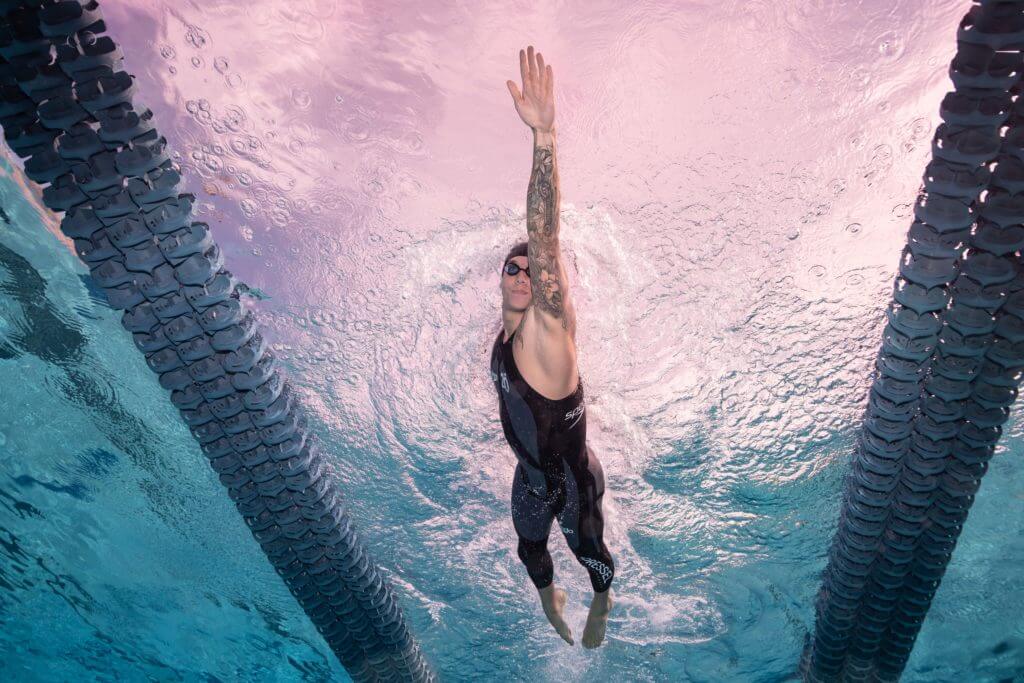Does a Suit Make a Swimmer?

Does a Suit Make a Swimmer?
By Daniel Zeng, Swimming World Intern
“The suit doesn’t make the swimmer. The swimmer makes the suit.” Caeleb Dressel, among many swimmers, has made this claim, asserting certain suits do not necessarily make you swim faster. It is a claim that has held true for many, but not all current world-record swims.
FINA prohibited supersuits from competition beginning in 2010. While the most recognizable was the Speedo LZR Racer, supersuits were an innovation that produced many of the fastest times in history. Several of the world records from that era more than 10 years ago have still not fallen.
Although shoulder-to-ankle suits were introduced in 2000, with Ian Thorpe coming to mind, what made these suits different was the addition of polyurethane. This material comprised half the suit and compressed tighter on the body, which improved buoyancy by creating tiny air pockets. Combining the two effects enhanced speed by minimizing loose skin and lifting the body higher on top of the water.
This “conversation” about supersuits re-emerged recently, following Speedo’s “Sub20” challenge where Dressel attempted to swim under 20 seconds in the 50-meter freestyle (short course), while donning the suit. Although this barrier was not broken, he spoke of the idea of an “Illegal Games” in a later interview, realizing his missed attempt could be an inspiration for something new in the future. He explained these proposed “Games” to be an ISL or Olympic style competitive environment of the world’s speediest swimmers, swimming in the suit. Dressel indeed might have broken 20 had he not only raced the clock, but also others beside him.
One likely discussion point would be whether this competition should be held in long or short course pools. Swims in 50-meter pools, where the emphasis is placed on the swimming itself, would ideally see more substantially improved times. In shorter 25 meter or yard pools, it would be more intriguing to see how much swimmers will have to alter their strokes since walls are your enemies now.
Specifically in short course, the suit removes the effectiveness of underwaters since its buoyancy constantly pulls you up. No full-body polyurethane suits mean that we as individuals cannot rely on our suit to do all the work for us. We accept more time and dedication is needed in and out of the water, developing adequate muscle structure so our bodies can travel weightlessly in the pool.
Supposing Speedo’s challenge motivates enough people, we could see similar ones involving the world’s top swimmers in each event.
Chances at records include Danas Rapsys, who could go for the 200 freestyle. Distance icon Gregorio Paltrinieri surely is eyeing that 800 freestyle record, having swum just shy of seven seconds of Zhang Lin’s 7:32.12 at Worlds in 2019. Ryan Murphy adding the 200 backstroke record held by Aaron Peirsol to his resume would not go unnoticed. The oldest world record held by Michael Phelps in the 400 individual medley is in danger here as well. Any record is equally endangered, although a bit of time would be needed to get accustomed to the suit’s feel.
Meanwhile, Kristof Milak, Murphy, and Dressel are three of the few who managed to break three of the supersuit records without the suits. Adam Peaty, in particular, has broken the 100 breaststroke world record five times, slashing 1.66 seconds in total off of Cameron Van Der Burgh’s mark. Not only does this indicate the suit may not be as huge a factor in fast times, but it promotes his self-developed technique.
Instead of lifting his head simultaneously with his hands on their initial out-sweep, Peaty’s head emerges when his hands are midway through the pull. Continuing to lower his own 100 breast world record, he is the only person below 58 and now 57 as of Worlds in 2019. It showcases one swimmer able to lower a world record multiple times using this unique stroking, despite not being in the super suited period. His ability to maintain an insanely fast stroke tempo through the vast majority of the race, further emphasizes a stricter focus on technique over the last 10 years. Given the opportunity to swim in the suit, Peaty might further obliterate his record.
Although polyurethane is now banned, women’s swimsuits at championship-level meets like the Olympics have remained “full-body,” while men’s were dialed down to below the waist at most. Out of the many long-course world records broken with the suits, 10 on the men’s side are holding strong, while a mere two remain for women. However, that ratio is narrowed down to 5-to-2 for short-course meters, male and female respectively. Not only does this signify fewer surviving world records overall, but the reduction of standing men’s records demonstrates the power of turns in short-course swimming. Great turns can “make up” for not surfacing earlier given that kicking underwater moves you farther quicker than swimming above water.
Regardless of if this relic ever rejoins our swim wardrobe, more swimmers are nearing and claiming those records for themselves year after year. The attention on diligent training will presumably allow for all decade-old records to be broken at last.
Adding the extra support of supersuits (in Dressel-like Speedo spectacles) can display the difference between human nature and science.
All commentaries are the opinion of the author and do not necessarily reflect the views of Swimming World Magazine nor its staff.



